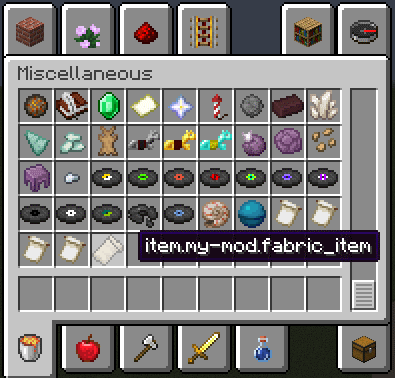This is an old revision of the document!
Table of Contents
添加物品
介绍
添加一个基本的物品是编写模组的第一步。你将需要创建一个 Item 对象,注册,并提供一个纹理。要向物品添加其他行为,你将需要一个自定义的 Item 类。在本教程以及以后的所有教程中,均使用 tutorial 作为命名空间。如果你有单独的模组 ID,那就直接使用它。
注册物品
首先,创建一个 Item 的实例,存储为静态常量字段。Item 的构造方法接受一个 Item.Settings(或 FabricItemSettings)对象,该对象用于设置物品属性,例如耐久和堆叠数量。
这里使用原版注册方式来注册,基本语法是
Registry#register(注册表类型, ID, 内容),注册表类型是存储在 Registries 或 Registry 对象中的静态字段,标识符用来给内容“加标签”。内容则是您添加的东西的一个实例。这可以随时调用,只要发生在初始化阶段。
现在新物品已添加到 Minecraft 中,运行“Minecraft Client”运行配置或者
runClient Gradle任务以查看它的运行情况,在游戏内执行命令 /give @s tutorial:custom_item。
为了简便,也可以像这样简化代码:
添加物品纹理
为物品注册纹理需要物品模型.json文件和纹理图像文件。 您将需要将它们添加到资源目录中。每个的直接路径是:
物品模型: <根目录>/resources/assets/tutorial/models/item/custom_item.json 物品纹理: <根目录>/resources/assets/tutorial/textures/item/custom_item.png
我们将使用这个示例纹理。
如果您在第一步中正确注册了物品,则游戏将以类似于以下方式的方式抱怨缺少纹理文件:
[Server-Worker-1/WARN]: Unable to load model: 'tutorial:custom#inventory' referenced from: tutorial:custom_item#inventory: java.io.FileNotFoundException: tutorial:models/item/custom_item.json
游戏能很方便地告诉你它想要的资源路径。遇事不决,日志解决。
一个非常简单的物品模型长这个样子:
{ "parent": "item/generated", "textures": { "layer0": "tutorial:item/custom_item" } }
物品模型会将所有属性继承自父模型,例如对工具、方块等物品十分有用的自定义手持模型(item/handheld)。textures/layer0 是纹理图像文件的位置。
最终纹理的结果:
创建物品类
要为物品添加自定义行为,则需要创建一个物品类。其默认的构造方法需要一个 Item.Settings 对象。
自定义物品类的一个实际用例是使该物品在右击时播放声音:
用新物品类的实例替换旧的 Item 对象:
如果你正确执行了所有操作,则使用该物品现在应该会播放声音。
如果我想更改物品的堆叠大小怎么办?
使用 FabricItemSettings 内的 maxCount(int size) 来指定最大堆叠数。请注意,如果你的物品是有耐久的(及耐久归零后会被破坏),那么此物品无法设置最大堆叠数,否则游戏将抛出 RuntimeException。
让物品能作为燃料或者可堆肥
如果需要让物品能作为燃料在熔炉中燃烧,可以使用 FuelRegistry,例如:
public class ExampleMod implements ModInitializer { [...] @Override public void onInitialize() { [...] FuelRegistry.INSTANCE.add(CUSTOM_ITEM, 300) } }
类似地,你也可以使用 CompostingChanceRegistry 来让它可以在堆肥桶中堆肥。


